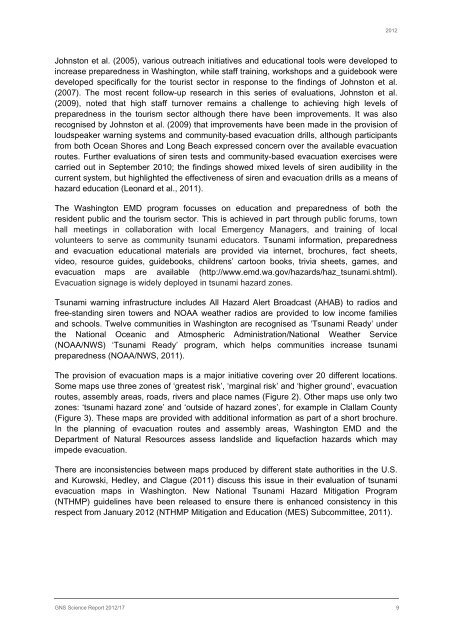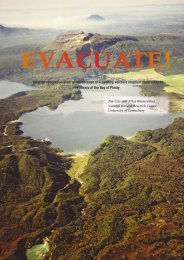Tsunami evacuation: Lessons from the Great East Japan earthquake ...
Tsunami evacuation: Lessons from the Great East Japan earthquake ...
Tsunami evacuation: Lessons from the Great East Japan earthquake ...
Create successful ePaper yourself
Turn your PDF publications into a flip-book with our unique Google optimized e-Paper software.
2012<br />
Johnston et al. (2005), various outreach initiatives and educational tools were developed to<br />
increase preparedness in Washington, while staff training, workshops and a guidebook were<br />
developed specifically for <strong>the</strong> tourist sector in response to <strong>the</strong> findings of Johnston et al.<br />
(2007). The most recent follow-up research in this series of evaluations, Johnston et al.<br />
(2009), noted that high staff turnover remains a challenge to achieving high levels of<br />
preparedness in <strong>the</strong> tourism sector although <strong>the</strong>re have been improvements. It was also<br />
recognised by Johnston et al. (2009) that improvements have been made in <strong>the</strong> provision of<br />
loudspeaker warning systems and community-based <strong>evacuation</strong> drills, although participants<br />
<strong>from</strong> both Ocean Shores and Long Beach expressed concern over <strong>the</strong> available <strong>evacuation</strong><br />
routes. Fur<strong>the</strong>r evaluations of siren tests and community-based <strong>evacuation</strong> exercises were<br />
carried out in September 2010; <strong>the</strong> findings showed mixed levels of siren audibility in <strong>the</strong><br />
current system, but highlighted <strong>the</strong> effectiveness of siren and <strong>evacuation</strong> drills as a means of<br />
hazard education (Leonard et al., 2011).<br />
The Washington EMD program focusses on education and preparedness of both <strong>the</strong><br />
resident public and <strong>the</strong> tourism sector. This is achieved in part through public forums, town<br />
hall meetings in collaboration with local Emergency Managers, and training of local<br />
volunteers to serve as community tsunami educators. <strong>Tsunami</strong> information, preparedness<br />
and <strong>evacuation</strong> educational materials are provided via internet, brochures, fact sheets,<br />
video, resource guides, guidebooks, childrens’ cartoon books, trivia sheets, games, and<br />
<strong>evacuation</strong> maps are available (http://www.emd.wa.gov/hazards/haz_tsunami.shtml).<br />
Evacuation signage is widely deployed in tsunami hazard zones.<br />
<strong>Tsunami</strong> warning infrastructure includes All Hazard Alert Broadcast (AHAB) to radios and<br />
free-standing siren towers and NOAA wea<strong>the</strong>r radios are provided to low income families<br />
and schools. Twelve communities in Washington are recognised as ‘<strong>Tsunami</strong> Ready’ under<br />
<strong>the</strong> National Oceanic and Atmospheric Administration/National Wea<strong>the</strong>r Service<br />
(NOAA/NWS) ‘<strong>Tsunami</strong> Ready’ program, which helps communities increase tsunami<br />
preparedness (NOAA/NWS, 2011).<br />
The provision of <strong>evacuation</strong> maps is a major initiative covering over 20 different locations.<br />
Some maps use three zones of ‘greatest risk’, ‘marginal risk’ and ‘higher ground’, <strong>evacuation</strong><br />
routes, assembly areas, roads, rivers and place names (Figure 2). O<strong>the</strong>r maps use only two<br />
zones: ‘tsunami hazard zone’ and ‘outside of hazard zones’, for example in Clallam County<br />
(Figure 3). These maps are provided with additional information as part of a short brochure.<br />
In <strong>the</strong> planning of <strong>evacuation</strong> routes and assembly areas, Washington EMD and <strong>the</strong><br />
Department of Natural Resources assess landslide and liquefaction hazards which may<br />
impede <strong>evacuation</strong>.<br />
There are inconsistencies between maps produced by different state authorities in <strong>the</strong> U.S.<br />
and Kurowski, Hedley, and Clague (2011) discuss this issue in <strong>the</strong>ir evaluation of tsunami<br />
<strong>evacuation</strong> maps in Washington. New National <strong>Tsunami</strong> Hazard Mitigation Program<br />
(NTHMP) guidelines have been released to ensure <strong>the</strong>re is enhanced consistency in this<br />
respect <strong>from</strong> January 2012 (NTHMP Mitigation and Education (MES) Subcommittee, 2011).<br />
GNS Science Report 2012/17 9

















